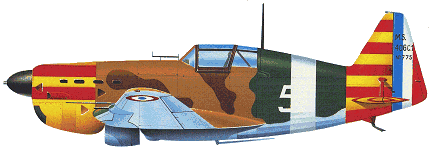|
| Numerically the most important Armee de l'Air fighter
at the commencement of World War II, the MS 406 combined
the structural design and equipment changes
applied to individual M.S.405s. Deliveries of the M.S.406
commenced late in 1938, a production tempo of six daily
being attained by April 1939, and 11 daily four months
later. Possessing an armament of one engine-mounted
20mm cannon and two 7.5mm machine guns, the M.S.406 had an 860hp Hispano-Suiza 12Y31 engine with
which it was markedly underpowered. Production terminated
in March 1940, at which time the Armee de
l'Air had taken on charge 1,064 M.S.406s, of which 30
had been supplied to Finland during December 1939-
January 1940, and 30 had gone to Turkey during
February-March 1940. Subsequent purchases from the
German authorities between late 1940 and late 1942
brought total procurement of the Morane-Saulnier
fighter by Finland to 87 aircraft (including a number of
M.S.410s). With the occupation of Vichy
France in November 1942, German forces acquired a
further 46 M.S.406s which (apart from two delivered to
Finland) were supplied to the Croat Air Force. The
Italians obtained 52 M.S.406s of which the 25 airworthy examples were delivered to the Regia Aeronautica.

| MODEL | M.S.406 |
| CREW | 1 |
| WEIGHTS |
| Take-off weight | 2426 kg | 5348 lb |
| Empty weight | 1893 kg | 4173 lb |
| DIMENSIONS |
| Wingspan | 10.61 m | 35 ft 10 in |
| Length | 8.13 m | 27 ft 8 in |
| Height | 2.71 m | 9 ft 11 in |
| Wing area | 17.10 m2 | 184.06 sq ft |
| PERFORMANCE |
| Max. speed | 486 km/h | 302 mph |
| Ceiling | 9400 m | 30850 ft |
| Range | 1000 km | 621 miles |
 | A three-view drawing (1280 x 934) |
| Aaron, e-mail, 13.12.2017 03:11 I do not have an answer to George's question about diving speed but I would guess the M.S.406 was not a great performer in this area.
According to Gaston Botquin, the author of Profile Publications No.147, the M.S.406 was the least effective French fighter in 1940 when compared to the H75, D.520 or Bloch 152.
Some pilot notes:
"She was an easy to fly, maneuverable and reliable plane."
"Their fighter was unable to intercept any high flying spy plane as the Dornier Do215B-1."
"They (pilots) experienced many difficulties to catch any German bomber which flew at lower altitudes because they flew faster than the Morane can do, even the Do 17. The only bomber she can catch was the Junker Ju 87 Stuka."
"They were completely outclassed by the Messerschmitt Bf 109E fighter."
"A lot of French pilots had lost their precious life because this plane was all, except a true fighter plane."
"The Morane 406, with her uncomfortable range and her slow cruising speed, was too much at risk in that country, directly under threat of the German aircrafts."
Just a couple corrections I would like to make in the specifications up above:
1. The wing area of the M.S.406 is 172.223 sq. ft.
2. At 2,450 kg. (5,401 lb.), range was 466 mls.
on 88 gallons of internal fuel. reply | | George, e-mail, 28.03.2013 14:39 How fast could the 406 Dive? I had some tell me it would shake at around 300mph and would break apart in a dive before it reached 400mph. And others tell me it could dive over 450mph. I would love to know the truth but I can never find any information on it. reply | | Klaatu83, e-mail, 03.03.2013 19:46 This was somewhat comparable to the Hawker Hurricane, in that both were transitional designs, with airframes that were partially metal-covered and partially fabric-covered. However, the Hurricane had markedly better performance and firepower. The Finns, who enjoyed rather limited access to modern aircraft, acquired a considerable number of these fighters through their German allies, and seem to have liked them well enough, though apparently not so well as they did the Brewster Buffalo. The Finns seem to have done pretty well with these aircraft, rather better than the French did. But then, the Finns seem to have done pretty well with all the aircraft they managed to get, no matter how mediocre. reply | | Ben Beekman, e-mail, 07.03.2011 21:17 During the phony war between Sept. 3, 1939 and May 10, 1940, the French "Armee de l'Air" were unable to fly their Morane fighters during the winter due to lack of heating for the wing-mounted, low muzzle velocity, 7.5mm machine guns. They had also been in the process of converting from the MS406 to the Bloch 152 and the Dewoitine D520. As a result the MS406 was usually sent to attack German armored columns but its liquid-cooled engine was then vulnerable to anti-aircraft fire. The French lost about 300 MS 406 fighters during the Battle of France including 150 to Luftwaffe aircraft and anti-aircraft fire. The remainder were lost in accidents or damage during airfield evacuations during the German advance. The aircraft was underpowered compared to the Bf109E, it lacked armor protection for the pilot, and had unreliable radio equipment. Nevertheless it was easy to fly with excellent maneuverability and could easily outturn a Bf109E due to its lower wing loading. Its greatest successes were against the Bf110 and Ju88 formations, although victories over the Bf109 could also be had depending on the pilot's skill.
This information taken from "French Fighters of World War II" (Squadron /Signal Publications book by Alain Pelletier, dated 2002). reply |
|
Do you have any comments?
|
| 
COMPANY
PROFILE
All the World's Rotorcraft
|








